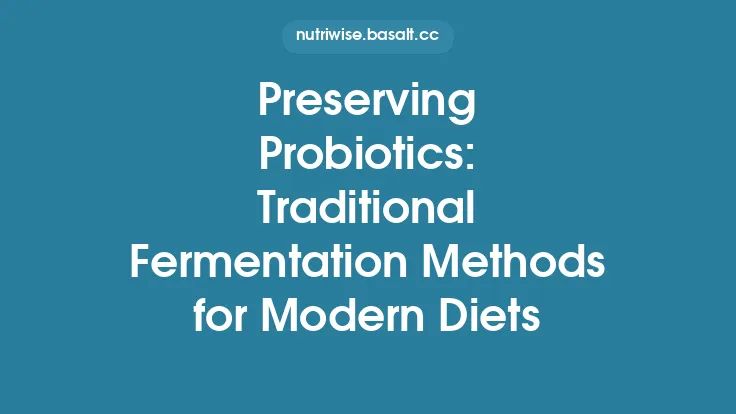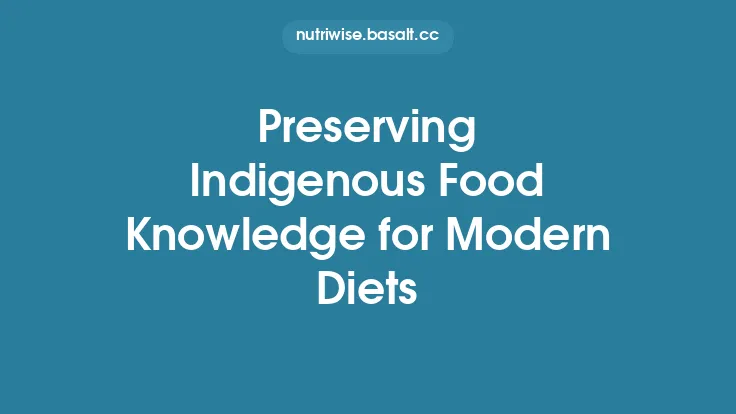Integrating traditional blessing rituals into modern diets offers a compelling way to honor cultural heritage while navigating today’s diverse culinary landscape. These practices, rooted in centuries‑old belief systems, often involve spoken prayers, symbolic gestures, and the preparation of specific foods that embody communal values, gratitude, and identity. By thoughtfully weaving these elements into contemporary meal planning, individuals and families can sustain a living connection to their ancestors, enrich the social fabric of dining, and foster a deeper sense of purpose around food. The following guide explores the cultural foundations of blessing rituals, outlines practical strategies for adaptation, and highlights considerations essential for preserving authenticity in a modern context.
Historical Context of Blessing Rituals
Traditional blessing rituals have emerged across the globe as integral components of communal life. Anthropologists categorize them under the broader umbrella of *ritualized food practices*, which serve to demarcate sacred time, reinforce social hierarchies, and transmit cultural narratives. In many societies, blessings are performed at pivotal moments—such as the first harvest, the birth of a child, or the commencement of a new year—linking the act of eating to cosmological cycles and communal memory.
- Agrarian societies often invoked deities of fertility and abundance, using specific grains or fruits as offerings. The blessing recited over these items was not merely a prayer but a performative act that symbolically transferred divine favor onto the community.
- Nomadic cultures employed portable blessings, focusing on the sanctity of water and fire, which accompanied them on migrations. The ritual language emphasized protection and guidance, reinforcing group cohesion during periods of uncertainty.
- Urbanized traditions adapted earlier agrarian rites to the constraints of city life, shifting the focus from field harvests to market purchases and kitchen spaces. The core intent—acknowledging a higher presence in the act of nourishment—remained unchanged.
Understanding these historical trajectories helps modern practitioners recognize the underlying logic of each ritual element, facilitating respectful adaptation rather than superficial imitation.
Core Elements of Traditional Blessing Practices
While the specifics vary widely, most blessing rituals share a set of structural components that can be identified and mapped onto contemporary meals:
- Invocation – A spoken or sung phrase that calls upon a deity, ancestor, or spiritual principle. The language often follows a formulaic pattern, employing repetition and meter to enhance memorability.
- Symbolic Offering – A particular food item (e.g., bread, rice, fruit) selected for its cultural symbolism. The choice may reflect seasonal availability, mythic significance, or social status.
- Gestural Component – Physical actions such as raising the hands, sprinkling water, or arranging the food in a specific pattern. These gestures encode meaning through spatial orientation and movement.
- Communal Recitation – The blessing is frequently repeated by multiple participants, reinforcing collective identity and shared responsibility.
- Consumption Sequence – The order in which the blessed food is eaten can carry hierarchical or narrative weight, often beginning with the eldest or most honored individual.
By dissecting a ritual into these elements, modern cooks can identify which aspects are essential for cultural fidelity and which can be flexibly reinterpreted.
Adapting Rituals to Contemporary Dietary Patterns
Modern diets are characterized by a broader array of ingredients, dietary restrictions, and culinary techniques than those available to the original practitioners. Successful integration therefore requires a balance between *cultural continuity and practical feasibility*.
- Ingredient Substitution – When a traditional offering is unavailable or incompatible with dietary restrictions (e.g., gluten intolerance), select a substitute that mirrors the original’s symbolic attributes. For instance, if wheat bread symbolizes fertility, a gluten‑free oat loaf can serve a comparable function while respecting health considerations.
- Temporal Alignment – Many blessings are tied to seasonal cycles. Align modern meals with these cycles by sourcing locally‑grown produce that corresponds to the traditional harvest period, thereby preserving the seasonal resonance of the ritual.
- Culinary Technique Translation – Traditional preparation methods (e.g., open‑fire roasting) can be reinterpreted using contemporary appliances (e.g., convection ovens) without losing the ritual’s essence, provided the sensory outcomes—smell, texture, visual presentation—remain faithful.
- Multilingual Invocation – In multicultural households, the blessing may be rendered in multiple languages. Maintaining the original phrasing alongside a translation can honor linguistic heritage while ensuring comprehension.
These adaptations should be guided by a principle of *equivalence*: the substituted element must convey a comparable cultural meaning, even if its material form differs.
Practical Guidelines for Incorporation
- Research the Origin – Begin with a thorough review of the specific blessing’s cultural background, consulting primary sources, community elders, or scholarly works. Document the ritual’s purpose, language, and symbolic items.
- Create a Ritual Blueprint – Draft a step‑by‑step outline that lists each component (invocation, offering, gesture, etc.) and notes any planned adaptations. This blueprint serves as a reference during meal preparation.
- Prepare the Offering – Produce the symbolic food item in advance, allowing time for any necessary fermentation, proofing, or seasoning that aligns with traditional methods.
- Design the Space – Arrange the dining area to reflect the ritual’s spatial logic. For example, if the original practice positions the offering at the north side of the table, replicate this orientation in the modern setting.
- Engage Participants – Invite family members or guests to learn the invocation and gestures. Conduct a brief rehearsal if the ritual involves coordinated movement.
- Execute the Blessing – Perform the ritual in its entirety before the meal begins, ensuring that each element is observed with intention.
- Document the Experience – Record reflections, variations, and participant feedback. This documentation supports intergenerational transmission and future refinements.
By following these steps, the integration becomes a deliberate, repeatable practice rather than an ad‑hoc addition.
Maintaining Cultural Integrity
Preserving the authenticity of a blessing ritual involves more than replicating its outward form; it requires an ongoing commitment to the values it embodies.
- Community Consultation – Seek guidance from cultural custodians or religious leaders to verify that adaptations remain respectful. Their endorsement can prevent inadvertent misrepresentation.
- Language Preservation – When possible, retain the original language of the invocation, even if participants also use a translation. This practice safeguards linguistic heritage.
- Narrative Contextualization – Share the story behind the ritual with diners. Understanding the mythic or historical context deepens appreciation and discourages superficial performance.
- Avoid Commercialization – Refrain from commodifying the ritual for profit or social media spectacle. The focus should remain on communal reverence rather than external validation.
These measures help ensure that the ritual continues to serve its intended cultural function within a modern framework.
Community Engagement and Shared Meals
Blessing rituals are inherently social, reinforcing bonds among participants. Integrating them into contemporary meals can revitalize communal dining experiences:
- Intergenerational Gatherings – Organize events where elders lead the blessing, allowing younger members to observe and eventually assume the role. This dynamic fosters mentorship and cultural continuity.
- Cross‑Cultural Exchanges – Invite neighbors from different backgrounds to share their own food blessings. Such exchanges promote mutual respect and broaden participants’ cultural literacy.
- Public Celebrations – Incorporate the ritual into community festivals, school programs, or cultural heritage days. Public visibility affirms the ritual’s relevance and encourages broader participation.
By positioning the blessing as a shared cultural touchstone, its integration transcends the individual household and contributes to a vibrant communal tapestry.
Ethical and Sustainable Considerations
Modern dietary choices are increasingly informed by ethical and environmental concerns. Aligning traditional blessing rituals with these values can enhance their contemporary relevance:
- Sourcing Locally – Whenever the ritual specifies a particular grain, fruit, or animal product, prioritize local producers to reduce carbon footprints and support regional economies.
- Animal Welfare – If the offering traditionally involves animal-derived foods, consider humane sourcing practices or plant‑based alternatives that retain symbolic meaning.
- Waste Minimization – Design the ritual to use all parts of the offering, reflecting traditional practices that avoid waste. Composting leftover portions further aligns the ritual with sustainable principles.
These considerations demonstrate that reverence for tradition can coexist with modern ethical standards.
Potential Pitfalls and How to Navigate Them
- Over‑Simplification – Reducing a complex ritual to a single phrase or gesture can strip it of meaning. Counter this by preserving the full structure and providing contextual explanations.
- Cultural Appropriation – Adopting a ritual without proper acknowledgment or permission may cause offense. Mitigate this risk through respectful consultation and transparent attribution.
- Incompatibility with Dietary Restrictions – Ignoring participants’ allergies or religious dietary laws can lead to exclusion. Conduct pre‑meal surveys to identify constraints and plan appropriate adaptations.
- Loss of Intentionality – Performing the blessing mechanically, without mindfulness, undermines its purpose. Encourage participants to engage emotionally and intellectually with each component.
- Commercial Exploitation – Using the ritual as a marketing gimmick can erode its sacredness. Maintain a clear boundary between cultural practice and commercial activity.
By anticipating these challenges, practitioners can safeguard the ritual’s integrity and ensure a respectful, enriching experience.
Resources for Further Exploration
- Ethnographic Compendiums – Collections such as *Rituals of the World* (edited by J. Smith) provide detailed descriptions of blessing practices across cultures.
- Community Organizations – Local cultural centers, heritage societies, and religious institutions often host workshops on traditional food rituals.
- Academic Journals – Publications like *Food, Culture & Society and Anthropology of Food* feature peer‑reviewed articles on the sociocultural dimensions of blessing rituals.
- Multimedia Archives – Digital repositories (e.g., the UNESCO Intangible Cultural Heritage database) contain audio recordings of invocations and visual documentation of ceremonial setups.
- Consultation Networks – Platforms such as the International Association of Culinary Anthropologists connect practitioners with scholars and cultural custodians for guidance.
Engaging with these resources deepens understanding, supports accurate adaptation, and fosters connections with the broader community of ritual practitioners.
Integrating traditional blessing rituals into modern diets is a nuanced endeavor that balances reverence for ancestral practices with the realities of contemporary life. By dissecting the structural components of rituals, thoughtfully adapting ingredients and techniques, and maintaining a steadfast commitment to cultural integrity, individuals can create meaningful, evergreen food experiences that honor the past while nourishing present‑day communities.





